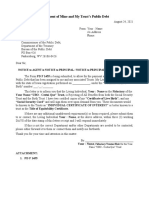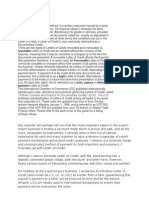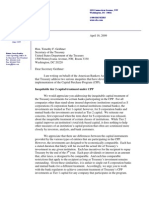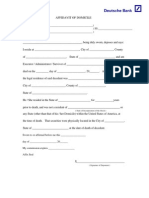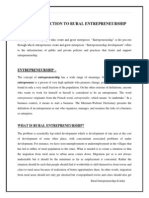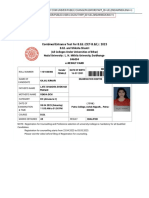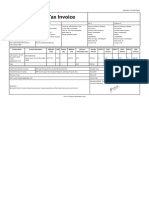Letter of Credit
Letter of Credit
Uploaded by
rapols9Copyright:
Available Formats
Letter of Credit
Letter of Credit
Uploaded by
rapols9Original Description:
Original Title
Copyright
Available Formats
Share this document
Did you find this document useful?
Is this content inappropriate?
Copyright:
Available Formats
Letter of Credit
Letter of Credit
Uploaded by
rapols9Copyright:
Available Formats
9 Steps in the Letter of Credit Process I. II. III. IV. V. VI. VII. VIII. IX.
Buyer and seller agree to terms including means of transport, period of credit offered (if any), and latest date of shipment acceptable. Buyer applies to bank for issue of letter of credit. Bank will evaluate buyer's credit standing, and may require cash cover and/or reduction of other lending limits. Issuing bank issues LC, sending it to the Advising bank by airmail or electronic means such as telex or SWIFT. Advising bank establishes authenticity of the letter of credit using signature books or test codes, then informs seller (beneficiary). Seller should now check that LC matches commercial agreement and that all its terms and conditions can be satisfied. Seller ships the goods, then assembles the documents called for in the LC (invoice, transport document, etc.). The Advising bank checks the documents against the LC. If the documents are compliant, the bank pays the seller and forwards the documents to the Issuing bank. The Issuing bank now checks the documents itself. If they are in order, it reimburses the seller's bank immediately. The Issuing bank debits the buyer and releases the documents (including transport document), so the buyer can claim the goods from the carrier. About LCs About the Process
Letter of Credit
What is a Letter of Credit? A Letter of Credit is a payment term generally used for international sales transactions. It is basically a mechanism, which allows importers/buyers to offer secure terms of payment to exporters/sellers in which a bank (or more than one bank) gets involved. The technical term for Letter of credit is 'Documentary Credit'. At the very outset one must understand is that Letters of credit deal in documents, not goods. The idea in an international trade transaction is to shift the risk from the actual buyer to a bank. Thus a LC (as it is commonly referred to) is a payment undertaking given by a bank to the seller and is issued on behalf of the applicant i.e. the buyer. The Buyer is the Applicantand the Seller is the Beneficiary. The Bank that issues the LC is referred to as the Issuing Bank which is generally in the country of the Buyer. The Bank that Advises the LC to the Seller is called the Advising Bank which is generally in the country of the Seller. The specified bank makes the payment upon the successful presentation of the required documents by the seller within the specified time frame. Note that the Bank scrutinizes the 'documents' and not the 'goods' for making payment. Thus the process works both in favor of both the buyer and the seller. The Seller gets assured that if documents are presented on time and in the way that they have been requested on the LC the payment will be made and Buyer on the other hand is assured that the bank will thoroughly examine these presented documents and ensure that they meet the terms and conditions stipulated in the LC.
Typically the documents requested in a Letter of Credit are the following:
Commercial invoice Transport document such as a Bill of lading or Airway bill, Insurance document; Inspection Certificate Certificate of Origin But there could be others too.
Letters of credit (LC) deal in documents, not goods. The LC could be 'irrevocable' or 'revocable'. An irrevocable LC cannot be changed unless both the buyer and seller agree. Whereas in a revocable LC changes to the LC can be made without the consent of the beneficiary. A 'sight' LC means that payment is made immediately to the beneficiary/seller/exporter upon presentation of the correct documents in the required time frame. A 'time' or 'date' LC will specify when payment will be made at a future date and upon presentation of the required documents. Essential Principles Governing Law Within the United States, Article 5 of the Uniform Commercial Code (UCC) governs L/Cs. Article 5 is founded on two principles: (1) the L/C,s independence from the underlying business transaction, and (2) strict compliance with documentary requirements. 1) Strict Compliance How strict compliance? Some courts insist upon literal compliance, so that a misspelled name or typographical error voids the exporter's/beneficiary's/seller's demand for payment. Other courts require payment upon substantial compliance with documentary requirements. The bank may insist upon strict compliance with the requirements of the L/C. In the absence of conformity with the L/C, the Seller cannot force payment and the bank pays at its own risk. Sellers should be careful and remember that the bank may insist upon strict compliance with all documentary requirements in the LC. If the documents do not conform, the bank should give the seller prompt, detailed notice, specifying all discrepancies and shortfalls. 2) The Independence Doctrine
Letters of credit deal in documents, not goods. L/Cs are purely documentary transactions, separate and independent
from the underlying contract between the Buyer and the Seller. The bank honoring the L/C is concerned only to see that the documents conform with the requirements in the L/C. If the documents conform, the bank will pay, and obtain reimbursement from the Buyer/Applicant. The bank need not look past the documents to examine the underlying sale of merchandise or the product itself. The letter of credit is independent from the underlying transaction and, except in rare cases of fraud or forgery, the issuing bank must honor conforming documents. Thus, Sellers are given protections that the issuing bank must honor its demand for payment (which complies with the terms of the L/C) regardless of whether the goods conform with the underlying sale contract. 3 Most Common Reasons why Letters of Credit Fail 1) Time Lines:
The letter of credit should have an expiration date that gives sufficient time to the seller to get all the tasks specified and the documents required in the LC. If the letter of credit expires, the seller is left with no protection. Most LC s fail because Sellers/Exporters/Beneficiaries were unable to perform within the specified time frame in the LC. Three dates are of importance in an LC: a) The date by when shipment should have occurred. The date on the Bill of Lading. b) The date by when documents have to be presented to the Bank c) The expiry date of the LC itself. A good source to give you an idea of the timelines would be your freight forwarding agent. As a seller check with your freight forwarding agent to see if you would be in a position to comply. 2) Discrepancy within the Letter of Credit: Letters of credit could also have discrepancies. Even a discrepancy as small as a missing period or comma can render the document invalid. Thus, the earlier in the process the letter of credit is examined, the more time is available to identify and fix the problem. This is another common reason why LCs fail. 3) Compliance with the Documents and Conditions within the Letter of Credit. Letters of credit are about documents and not facts; the inability to produce a given document at the right time will nullify the letter of credit. As a Seller/Exporter/Beneficiary you should try and run the compliance issues with the various department or individuals involved within your organization to see if compliance would be a problem. And if so, have the LC amended before shipping the goods. Learning the Terminology of Exporting INCOTERMS (TRANSPORTATION) Shipping terms set the parameters for international shipments, specify points of origin and destination, outline conditions under which title is transferred from seller to buyer, and determine which party is responsible for shipping costs. They also indicate which party assumes the cost if merchandise is lost or damaged during transit. To provide a common terminology for international shipping, INCOTERMS (International Commercial Terms) have been developed under the auspices of the International Chamber of Commerce. See their
A Letter of Credit Typical Transaction
Below is the typical process that takes place when payment is made by an irrevocable letter of credit, which a U.S. bank confirmed: 1. After the exporter and customer agree on the terms of sale, the customer arranges for its bank to open a letter of credit. Delays may be encountered if, for example, the buyer had insufficient funds. 2. The buyer's bank prepares an irrevocable letter of credit, including all instructions to the seller concerning the shipment.
3. The buyer's bank sends the irrevocable letter of credit to a U.S. bank requesting confirmation. The exporter may request that a particular U.S. bank be the confirming bank, or the foreign bank may select one of its U.S. correspondent banks. 4. The U.S. bank prepares a letter of confirmation to forward to the exporter along with the irrevocable letter of credit. 5. The exporter reviews carefully all conditions in the letter of credit. The exporter's freight forwarder should be contacted to make sure that the shipping date can be met. If the exporter cannot comply with one or more of the conditions, the buyer should be alerted at once. 6. The exporter arranges with the freight forwarder to deliver the goods to the appropriate port or airport. 7. When the goods are loaded, the forwarder completes the necessary documents. 8. The exporter (or freight forwarder) presents to the U.S. bank documents indicating full compliance with the terms stated in the letter of credit. 9. The bank reviews the documents. If they are in order, the documents are airmailed to the buyer's bank for review and transmitted to the buyer. 10. The buyer (or agent) gets the documents that may be needed to claim the goods. 11. A draft, which may accompany the letter of credit, is paid by the exporter's bank at the time specified or may be discounted at an earlier date.
You might also like
- Human Resources Planning in Hotel Industry FinalDocument40 pagesHuman Resources Planning in Hotel Industry Finalrapols983% (18)
- Currency ExchangeDocument1 pageCurrency ExchangetrustkonanNo ratings yet
- Organizational Conflicts in NestléDocument16 pagesOrganizational Conflicts in Nestlérapols933% (6)
- Maternity Benefit ProjectDocument16 pagesMaternity Benefit ProjectS1626100% (1)
- Walker Filed Petition For Rehearing and Petition For Rehearing en BancDocument12 pagesWalker Filed Petition For Rehearing and Petition For Rehearing en BancjhbryanNo ratings yet
- Kassa v. Detroit Metro - Welcome To The D Trademark Complaint PDFDocument10 pagesKassa v. Detroit Metro - Welcome To The D Trademark Complaint PDFMark JaffeNo ratings yet
- Recording Cover Sheet PDFDocument1 pageRecording Cover Sheet PDFSalaam Bey®No ratings yet
- Unit-Iv: Meaning of A Banking CompanyDocument39 pagesUnit-Iv: Meaning of A Banking CompanyVandana SharmaNo ratings yet
- Form 8 Assignment For The General Benefit of CreditorsDocument1 pageForm 8 Assignment For The General Benefit of CreditorsRisah ahhhNo ratings yet
- My IndemnityDocument1 pageMy IndemnityJeromeKmtNo ratings yet
- Valley National BankDocument3 pagesValley National BankAmbassador: Basadar: Qadar-Shar™, D.D. (h.c.) aka Kevin Carlton George™100% (1)
- Bureau of The Public Debt LetterDocument1 pageBureau of The Public Debt LetterJohnnyLarsonNo ratings yet
- 1099aexampleDocument1 page1099aexampleMike GriffinNo ratings yet
- 01 - 04 - Declaration of Conversion by I AMDocument2 pages01 - 04 - Declaration of Conversion by I AMWilli Wallace100% (1)
- Copyright Clearance LetterDocument1 pageCopyright Clearance LetterTommy cleggettNo ratings yet
- ABH-072018-BLAB201 Re: R vs. Boisjoli 2018 ABQB 410 (CanLII)Document2 pagesABH-072018-BLAB201 Re: R vs. Boisjoli 2018 ABQB 410 (CanLII)Allen-nelson of the Boisjoli familyNo ratings yet
- Bankruptcy DeclarationDocument30 pagesBankruptcy DeclarationBostonBizJournal100% (1)
- Thomas Willing Financial History Glossary2Document44 pagesThomas Willing Financial History Glossary2JkNo ratings yet
- IRS Publication Form 706Document4 pagesIRS Publication Form 706Francis Wolfgang UrbanNo ratings yet
- Preview 2780 2Document2 pagesPreview 2780 2Sylvester MooreNo ratings yet
- International Commercial Lien ABH-012009-CL1Document2 pagesInternational Commercial Lien ABH-012009-CL1Allen-nelson of the Boisjoli familyNo ratings yet
- Verification JuratDocument1 pageVerification JuratGreg WilderNo ratings yet
- GPO CRECB 1933 pt1 v77 4Document68 pagesGPO CRECB 1933 pt1 v77 4Susan CrossNo ratings yet
- Acknowledgment PoaDocument2 pagesAcknowledgment PoajoeNo ratings yet
- Documents Used in Import-Export Bill of ExchangeDocument2 pagesDocuments Used in Import-Export Bill of ExchangeHallucinations FoamNo ratings yet
- BFRReportImage AspxDocument2 pagesBFRReportImage Aspxscottk929No ratings yet
- Capitis Diminutio MaximaDocument1 pageCapitis Diminutio MaximaJimHolmes0% (1)
- Bill of LadingDocument13 pagesBill of LadingButt ManNo ratings yet
- Inquiry Removal Letter 1aDocument1 pageInquiry Removal Letter 1aYarod ELNo ratings yet
- Mississippi Mechanics Lien PDFDocument3 pagesMississippi Mechanics Lien PDFLeslie MayhallNo ratings yet
- Form 28 Application For Grant of No Objection Certificate: (See Rule 54, 58 (1), (3) and (4) )Document2 pagesForm 28 Application For Grant of No Objection Certificate: (See Rule 54, 58 (1), (3) and (4) )kumarabhi09No ratings yet
- Discharge of ContractDocument15 pagesDischarge of ContractNur HmNo ratings yet
- Helen Bloore Equity Bond-Payable Immediately To Max Igan's in Lak'Ech FoundationDocument2 pagesHelen Bloore Equity Bond-Payable Immediately To Max Igan's in Lak'Ech FoundationHelen Bloore100% (1)
- I1099msc DFTDocument11 pagesI1099msc DFTVa Kho100% (1)
- Certificate of CitizenshipDocument1 pageCertificate of CitizenshipAmbassador: Basadar: Qadar-Shar™, D.D. (h.c.) aka Kevin Carlton George™No ratings yet
- 1.4 IRS Form 1040V REVERSEDocument1 page1.4 IRS Form 1040V REVERSEBruce Johnson100% (1)
- Domicile PDFDocument0 pagesDomicile PDFNETER432No ratings yet
- 12 Tribes Diplomatic MissionDocument3 pages12 Tribes Diplomatic MissionAmbassador: Basadar: Qadar-Shar™, D.D. (h.c.) aka Kevin Carlton George™No ratings yet
- 10-01-27 US Office of Comptroller of the Currency: Complaint against Bank of America (Case # 00971981) -alleging conduct amounting to racketeering by Bank of America and Brian Moynihan - Response to Compalint sDocument4 pages10-01-27 US Office of Comptroller of the Currency: Complaint against Bank of America (Case # 00971981) -alleging conduct amounting to racketeering by Bank of America and Brian Moynihan - Response to Compalint sHuman Rights Alert - NGO (RA)100% (1)
- Revocable Letter of Credit Can Be Revoked Without The Consent of TheDocument3 pagesRevocable Letter of Credit Can Be Revoked Without The Consent of ThePankaj ThapaNo ratings yet
- Llen Oisjoli Oldings: A B H ™ Photini Papadaptu, Acting For: The Government of Alberta As Special Crown ProsecutorDocument3 pagesLlen Oisjoli Oldings: A B H ™ Photini Papadaptu, Acting For: The Government of Alberta As Special Crown ProsecutorAllen-nelson of the Boisjoli familyNo ratings yet
- Rxi Pharmaceuticals Corporation: Form 8-KDocument3 pagesRxi Pharmaceuticals Corporation: Form 8-KAnonymous Feglbx5No ratings yet
- Report Promissory NoteDocument4 pagesReport Promissory NoteSaiyidah syafiqah100% (1)
- Sornson Tort Claim NoticeDocument6 pagesSornson Tort Claim NoticeStatesman JournalNo ratings yet
- Avoid IRS Backup Withholding Your Card Sales Settlement at A Rate of 28%Document2 pagesAvoid IRS Backup Withholding Your Card Sales Settlement at A Rate of 28%James LeeNo ratings yet
- American Bankers Association Letter To Treasury Secretary Timothy GeithnerDocument3 pagesAmerican Bankers Association Letter To Treasury Secretary Timothy GeithnerFOXBusiness.comNo ratings yet
- Nuremberg Notice Form 2021Document1 pageNuremberg Notice Form 2021Manny Pineda100% (1)
- Acknowledgment by Attorney in FactDocument2 pagesAcknowledgment by Attorney in FactFreeman LawyerNo ratings yet
- Letterto Withdrawnlaws4receiptDocument1 pageLetterto Withdrawnlaws4receiptDarrell WilsonNo ratings yet
- PC 50 v. Fox 40 InternationalDocument6 pagesPC 50 v. Fox 40 InternationalPriorSmartNo ratings yet
- Ucc 1Document42 pagesUcc 1Glenn Augenstein100% (1)
- Sec Form DDocument5 pagesSec Form DPando DailyNo ratings yet
- Notice of StandingDocument1 pageNotice of StandingGee PennNo ratings yet
- Ucc-1 Text For Real Estate PropertyDocument1 pageUcc-1 Text For Real Estate PropertyJason Henry100% (3)
- Kurt Registration NumberDocument15 pagesKurt Registration Numberpaula_morrill668100% (2)
- 18 U.S. Code 1519 - Destruction, Alteration, or Falsification of Records in Federal InvestigationsDocument4 pages18 U.S. Code 1519 - Destruction, Alteration, or Falsification of Records in Federal InvestigationsBaqi-Khaliq Bey100% (1)
- Love, Law and Trust INDEED These Three Are OneDocument3 pagesLove, Law and Trust INDEED These Three Are OneWithout the UNITED STATES/DISTRICT OF COLUMBIA (Luke 11:52)100% (2)
- 12 USC 95aDocument25 pages12 USC 95aCraig PainterNo ratings yet
- Commission of Plenipotentiary FinalDocument1 pageCommission of Plenipotentiary FinalChristine FitzpatrickNo ratings yet
- Huge Claim of RightDocument50 pagesHuge Claim of Rightsperman1313No ratings yet
- Intent To VacateDocument1 pageIntent To VacatemoNo ratings yet
- Affidavit of Domicile: (State of Incorporation of The Stock)Document1 pageAffidavit of Domicile: (State of Incorporation of The Stock)anon-314170No ratings yet
- The Laws Of War, Affecting Commerce And ShippingFrom EverandThe Laws Of War, Affecting Commerce And ShippingNo ratings yet
- Orgnl ConflictsDocument27 pagesOrgnl Conflictsrapols9No ratings yet
- ENTREPRENEUR - "Entrepreneurs" Are People Who Create and Grow EnterprisesDocument23 pagesENTREPRENEUR - "Entrepreneurs" Are People Who Create and Grow Enterprisesrapols9No ratings yet
- Final Business StratagyDocument47 pagesFinal Business Stratagyrapols9No ratings yet
- Bajaj IndexDocument6 pagesBajaj Indexrapols9No ratings yet
- Rural EntrepreneurshipDocument44 pagesRural Entrepreneurshiprapols9100% (4)
- Organizational CultureDocument36 pagesOrganizational Culturerapols9100% (1)
- Just DialDocument3 pagesJust Dialrapols9No ratings yet
- Mobile Marketing Final To PrintDocument97 pagesMobile Marketing Final To Printrapols9No ratings yet
- Executive SummaryDocument41 pagesExecutive Summaryrapols9No ratings yet
- S MDocument60 pagesS Mrapols9No ratings yet
- Business PlanDocument28 pagesBusiness Planrapols9100% (3)
- New Fluas101 Slup Flag FlagtDocument31 pagesNew Fluas101 Slup Flag FlagtCarolyn Lodevico AlaNo ratings yet
- Assignment On Professional EthicsDocument18 pagesAssignment On Professional EthicsDathrang PajatNo ratings yet
- Lalit Narayan Mithila UniversityDocument2 pagesLalit Narayan Mithila Universityshahab deviilNo ratings yet
- Tax InvoiceDocument1 pageTax InvoiceSuraj KumarNo ratings yet
- Campbell - National DeconstructionDocument322 pagesCampbell - National Deconstructionoblivnow100% (2)
- Blung 07Document10 pagesBlung 07JNE NgadirejoNo ratings yet
- GeM Bidding 5782919Document44 pagesGeM Bidding 5782919DHEERAJ JAINNo ratings yet
- Wise 271276736 2810 - 42Document3 pagesWise 271276736 2810 - 42Soslew DoeksNo ratings yet
- One-Blue Et. Al. v. ImationDocument20 pagesOne-Blue Et. Al. v. ImationPriorSmartNo ratings yet
- Case Digest - G.R. No. 226908 1Document4 pagesCase Digest - G.R. No. 226908 1Roselyn PascobelloNo ratings yet
- Land Law 1 CW GRP 1-1Document17 pagesLand Law 1 CW GRP 1-1bitature timothyNo ratings yet
- Institute of Medicine. 1990. Medicare A Strategy For Quality Assurance, VolumeDocument462 pagesInstitute of Medicine. 1990. Medicare A Strategy For Quality Assurance, Volumeodnak.zerimNo ratings yet
- Batas Pambansa Bilang 68Document29 pagesBatas Pambansa Bilang 68Lyka Lim PascuaNo ratings yet
- Sveti PatrikDocument1 pageSveti Patrikzvonimir bosnjakNo ratings yet
- Kesher Fall 2023 Election Packet-2Document15 pagesKesher Fall 2023 Election Packet-2kylikatzNo ratings yet
- Homeplus Loan Application CorpDocument2 pagesHomeplus Loan Application CorpPascual D Monsanto JrNo ratings yet
- Womens Legal Rights HandbookDocument212 pagesWomens Legal Rights Handbooksupriya kadamNo ratings yet
- AE515212Document81 pagesAE515212cxNo ratings yet
- Devolution ResearchDocument3 pagesDevolution Researchs60573No ratings yet
- Tutorial 12 13 14 BBBL2023Document16 pagesTutorial 12 13 14 BBBL2023YANG YUN RUINo ratings yet
- In The High Court of Delhi at New Delhi: Via Video-ConferencingDocument3 pagesIn The High Court of Delhi at New Delhi: Via Video-ConferencingsandeepNo ratings yet
- 05 VolII - Preamble To Price BidDocument6 pages05 VolII - Preamble To Price BidMAULIK RAVALNo ratings yet
- Barangay Peacekeeping Action TeamDocument2 pagesBarangay Peacekeeping Action TeamRhayver ValdezNo ratings yet
- Risk Management: Nitesh Kumar, Asst. Professor, LPUDocument14 pagesRisk Management: Nitesh Kumar, Asst. Professor, LPUVishal VigNo ratings yet
- WHO FWC WSH 17.03 EngDocument44 pagesWHO FWC WSH 17.03 EngRafaella BarachoNo ratings yet
- GRP 3.1 Copy 1Document19 pagesGRP 3.1 Copy 1Kier Paul Rosales CairelNo ratings yet
- 2022 Coling-1 540Document8 pages2022 Coling-1 540suryamishraNo ratings yet
- The Mess Merkel Leaves Behind The Economist 25 Sep 2021Document1 pageThe Mess Merkel Leaves Behind The Economist 25 Sep 2021robertovig1No ratings yet











